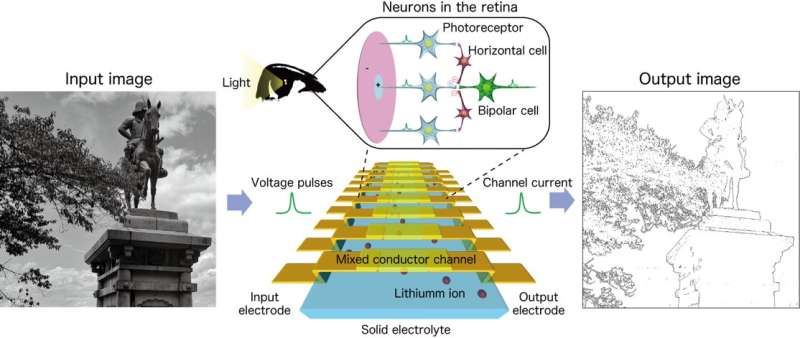Development of an artificial vision device capable of mimicking human optical illusions

Japan's National Institute for Materials Science (NIMS) has developed an ionic artificial vision device capable of increasing the edge contrast between the darker and lighter areas of an mage in a manner similar to that of human vision. This first-ever synthetic mimicry of human optical illusions was achieved using ionic migration and interaction within solids. It may be possible to use the device to develop compact, energy-efficient visual sensing and image processing hardware systems capable of processing analog signals.
Numerous artificial intelligence (AI) systems developers have recently shown a great deal of interest in research on various sensors and analog information processing systems inspired by human sensory mechanisms. Most AI systems on which research is being conducted require sophisticated software/programs and complex circuit configurations, including custom-designed processing modules equipped with arithmetic circuits and memory. These systems have disadvantages, however, in that they are large and consume a great deal of power.
The NIMS research team recently developed an ionic artificial vision device composed of an array of mixed conductor channels placed on a solid electrolyte at regular intervals. This device simulates the way in which human retinal neurons (i.e., photoreceptors, horizontal cells and bipolar cells) process visual signals by responding to input voltage pulses (equivalent to electrical signals from photoreceptors). This causes ions within the solid electrolyte (equivalent to a horizontal cell) to migrate across the mixed conductor channels, which then changes the output channel current (equivalent to a bipolar cell response). By employing such steps, the device, independent of software, was able to process input image signals and produce an output image with increased edge contrast between darker and lighter areas in a manner similar to the way in which the human visual system can increase edge contrast between different colors and shapes by means of visual lateral inhibition.
The human eye produces various optical illusions associated with tilt angle, size, color and movement, in addition to darkness/lightness, and this process is believed to play a crucial role in the visual identification of different objects. The ionic artificial vision device described here may potentially be used to reproduce these other types of optical illusions. The research team involved hopes to develop visual sensing systems capable of performing human retinal functions by integrating the subject device with other components, including photoreceptor circuits.
The research was published in Nano Letters.
More information: Xiang Wan et al, Neuromorphic System for Edge Information Encoding: Emulating Retinal Center-Surround Antagonism by Li-Ion-Mediated Highly Interactive Devices, Nano Letters (2021). DOI: 10.1021/acs.nanolett.1c01990



















